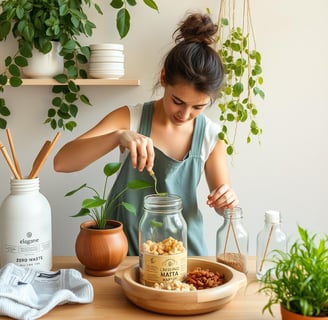A Beginner's Guide to Zero-Waste Living: Simple Steps to Get Started
Blog post description.
♻️LIFESTYLE & SUSTAINABILITY


As the world grapples with escalating environmental issues, the concept of zero-waste living has emerged as a sustainable alternative to our current consumption-driven lifestyle. This way of life advocates for minimizing waste generation to the greatest extent possible. It encourages individuals to rethink their habits and find innovative solutions to reduce their environmental impact. If you're new to the idea of zero waste and are eager to make a positive change, this guide will help you understand the principles of zero-waste living and provide practical steps to get started.
Understanding the Zero-Waste Philosophy
Zero-waste living is about more than just recycling; it revolves around the principle of moving away from a linear economy, where products are created, consumed, and discarded. Instead, it promotes a circular economy in which products are reused, repaired, and recycled to minimize waste. The ultimate goal is to divert waste from landfills and reduce the overall consumption of resources.
The zero-waste philosophy can be distilled into five core principles known as the "5 R's":
Refuse: Say no to things you do not need.
Reduce: Minimize what you consume and throw away.
Reuse: Give new life to items before discarding them.
Recycle: Process materials to create new products.
Rot: Compost organic waste to enrich the soil.
By adopting these principles, you can shift towards a more sustainable lifestyle that not only benefits the environment but also nourishes your personal well-being.
Getting Started: Simple Steps for Beginners
1. Assess Your Current Waste
Before diving into a zero-waste lifestyle, it’s important to understand what you throw away. For a week or two, keep a log of your waste by collecting it in a single bin. Record the types of items you dispose of and categorize them. This initial step will help you identify the areas where you can improve and what specific changes will make the most impact.
2. Refuse Single-Use Items
One of the easiest ways to start reducing waste is to refuse single-use items. Products such as plastic bags, straws, coffee cups, and water bottles contribute significantly to global waste. Invest in reusable alternatives like cloth shopping bags, stainless steel water bottles, and glass containers for food storage. By consciously choosing not to use disposable items, you’ll significantly cut back on your waste output.
3. Embrace Minimalism
The journey to zero waste goes hand in hand with being a minimalist. Reducing the number of items you own can lead to less waste overall. Start decluttering your home, focusing on quality over quantity. Donate or sell items you no longer need or use, allowing them to benefit someone else. The less you have, the less waste you will create.
4. Be Mindful of Your Purchases
Take a moment to think before you buy. Following the "three questions" rule can help you make more conscious purchasing decisions:
Do I really need this?
Is there a sustainable alternative?
What will happen to it after I’m done using it?
Prioritize quality items that are made from sustainable materials, and consider buying second-hand when possible. Thrift stores, online marketplaces, and community swaps are all great places to find pre-loved items, thus reducing the demand for new products.
5. Start Composting
Organic waste, including food scraps and yard waste, constitutes a large percentage of household waste. By composting, you can divert this waste from landfills and create nutrient-rich soil for your garden. Choose a composting method that suits your space and lifestyle—whether it’s a compost bin in your backyard, an indoor worm bin, or a community composting program.
6. Make Your Own Products
Many common household products come packaged in unnecessary plastic. Consider making your own cleaning supplies, personal care products, and food items. Simple recipes for homemade laundry detergent, deodorant, and all-purpose cleaners often use everyday ingredients like vinegar, baking soda, and essential oils. This not only reduces waste but can also save you money in the long run.
7. Build a Support System
Transitioning to a zero-waste lifestyle can be overwhelming, and it’s important to have support from friends, family, and community. Engage with local groups focused on sustainability and waste reduction, attend zero-waste workshops, or follow online platforms and social media accounts that share tips and inspiration. Surrounding yourself with like-minded individuals will provide motivation and make the journey enjoyable.
8. Set Realistic Goals
It’s vital to approach zero-waste living with the understanding that you don’t have to achieve perfection right away. Set small, achievable goals for yourself, and gradually work towards incorporating more zero-waste practices into your life. Celebrate your progress, practice patience, and remember that every small step counts towards a larger goal of sustainability.
Conclusion: Embracing the Journey
Zero-waste living is not an all-or-nothing approach but a journey towards more mindful consumption and a healthier planet. Start with small changes and gradually implement more zero-waste practices into your daily routine. As you progress, you’ll discover that living a sustainable lifestyle not only benefits the environment but enriches your life in unexpected ways.
By committing to the principles of zero-waste living and following these simple steps, you can take meaningful action to reduce your waste footprint and inspire others to do the same. Remember, each effort, no matter how small, contributes to a larger movement towards a sustainable future. Together, we can create a world where waste is minimized, resources are cherished, and our planet thrives.
